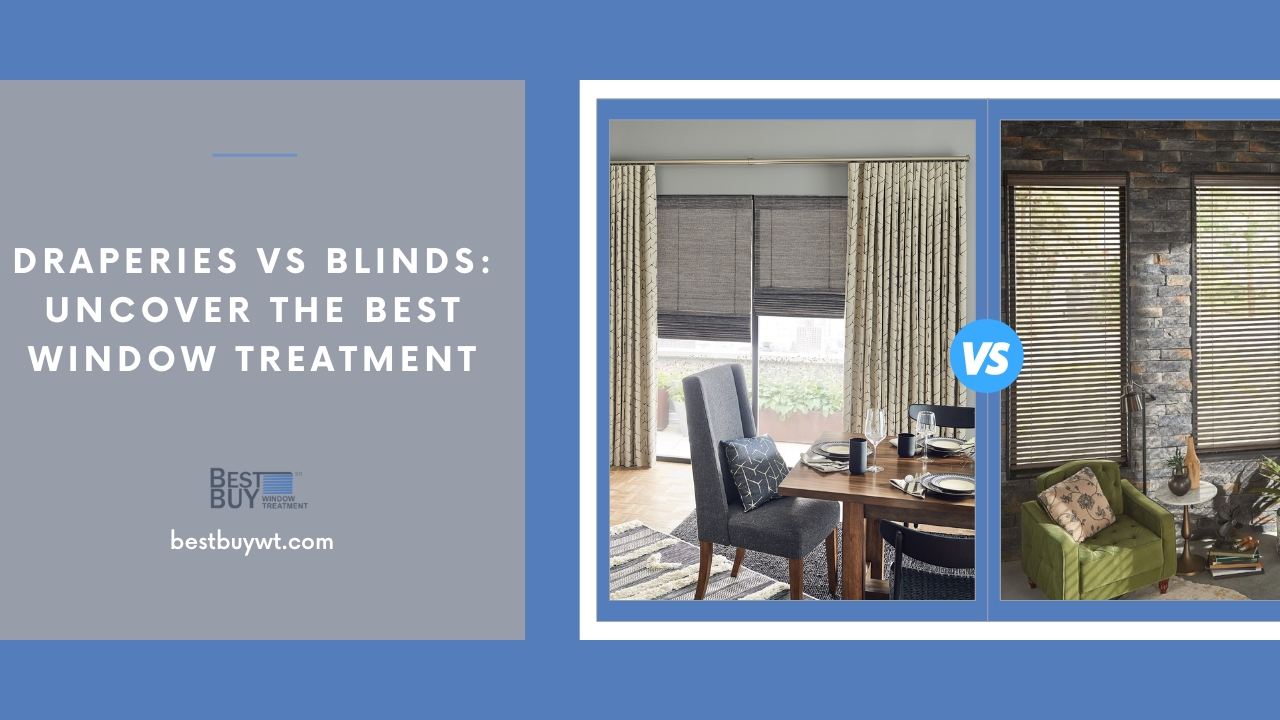When it comes to selecting a window treatment, there are plenty of options available. Draperies or blinds? Which one is the best window treatment for your home? It can be difficult to decide between draperies and blinds, so let’s take a closer look at each option.
In this article, we will uncover the best window treatments for any type of living situation. Plus, you’ll learn where to find the best deals on window treatments so that you can make an informed decision for your home!
Drapes
Drapes are a classic window treatment option that never goes out of style. They offer a variety of benefits, from controlling the amount of light that enters a room to providing privacy and adding an extra layer of insulation. Draperies can also be used to enhance the overall aesthetic appeal of a room by adding color, texture, and pattern.
When choosing draperies for your home, there are several factors to consider. The first is the material – heavier fabrics like velvet and suede are better suited for blocking light and insulating against cold temperatures, while lighter fabrics like cotton and linen allow more natural light to filter through.
The length and width of your draperies should also be taken into account; shorter curtains work well in smaller spaces, while longer ones can create an illusion of height in larger rooms.
Blinds
Blinds are an essential part of any home decor setup. In addition to offering privacy and light management, these window treatments enhance the room’s ambiance with a touch of sophistication. There are several options available, including wood, vinyl, and fabric.
Each has its own benefits and drawbacks; for example, wood blinds provide a classic look while vinyl blinds are more affordable and easier to maintain. Fabric blinds offer greater flexibility in terms of design options.
Another important consideration is the style of blind that best suits your needs. The most common styles include vertical, horizontal, roller, and Roman shades. Vertical blinds are great for large windows or sliding doors while horizontal ones work well for smaller windows or spaces with limited depth.
Pros of Drapes
First and foremost, draperies provide privacy and control over the amount of light entering a room. This level of control is especially important for bedrooms or living rooms where you may want to block out more light during certain hours of the day.
Additionally, draperies can help to insulate your home by blocking drafts from outside, keeping your space cozy in cooler months.
Beyond function, draperies also serve as an important decorative element in any room. With countless colors, patterns, and textures available on the market today, draperies can be tailored to fit any design aesthetic or personal style preference. Furthermore, they can easily be swapped out as tastes change or seasons shift without breaking the bank.
Cons of Drapes
While draperies can be a great way to add character and charm to any room, they also have several disadvantages. One major drawback is that draperies tend to gather dust and allergens, making them a poor choice for individuals with allergies or respiratory problems.
Additionally, draperies can be difficult to clean and maintain, requiring frequent washing or trips to the dry cleaner.
Another disadvantage of draperies is their limited lifespan. Over time, exposure to sunlight can cause fading and discoloration, leading to the need for replacement sooner than other types of window treatments.
Pros of Blinds
Blinds are an excellent choice for window treatments due to their versatility, functionality, and elegant appearance. One of the most significant benefits of blinds is that they provide effective privacy control. You can adjust the slats to your desired angle, allowing you to let in natural light while maintaining your privacy.
They come in various materials such as wood, faux wood or aluminum with different finishes and colors; thus giving homeowners many options for customizing their decor. Blinds are also low-maintenance compared to curtains which require frequent washing or dry cleaning.
Dusting or wiping down your blinds occasionally will keep them looking new and functional for years.
Finally, blinds are an excellent option for energy efficiency. They provide a layer of insulation against heat loss during colder months while blocking out unwanted heat from the sun during warmer months.
This helps reduce energy costs by keeping homes cooler in summer and warmer in winter while reducing the need for heating and cooling systems to work overtime to maintain comfortable indoor temperatures.
Cons of Blinds
While blinds may seem like a convenient option for window treatments, there are several cons to consider before making a purchase.
Firstly, dust and grime can accumulate on the slats over time, leading to unsightly stains that are difficult to remove.
Secondly, blinds offer limited insulation compared to draperies. During the colder months of the year, heat can escape through the gaps between the individual slats of a blind more easily than it would through thicker fabric. This means you may have to pay higher heating bills in order to keep your home warm.
What are the advantages of blinds over drapes?
One significant advantage of blinds is their versatility in controlling light and privacy. With the ability to adjust the angle of the slats, you can let in natural light while still maintaining privacy from prying eyes.
In contrast, draperies only offer full coverage or no coverage at all, making it difficult to find a balance between lighting and privacy.
Additionally, cleaning blinds is relatively easy as they can be wiped down with a damp cloth or easily dusted with a brush.
Moreover, they provide a smooth finish on windows compared to bulky draperies that may take up space or clash with other elements within the room’s design.
Cost Comparison: Which Costs Less?
In general, blinds tend to be less expensive than draperies, particularly when looking at basic models without any additional features or customizations. This is because blinds are made of simpler materials and have a more straightforward design that requires less labor to produce.
However, it’s worth noting that the cost comparison between draperies and blinds can vary depending on several factors.
For example, high-end or customized blinds may end up being more expensive than standard draperies options. Additionally, if you need to cover large or irregularly shaped windows, draperies could actually end up being the more cost-effective choice since they can be adjusted to fit virtually any space.
Styling Considerations
The answer largely comes down to personal preference and the styling considerations of your space. If you’re going for a more classic, traditional look, then draperies may be the way to go. They come in a variety of fabrics, colors, and patterns that can add warmth and texture to any room.
On the other hand, if you prefer a sleeker, more modern aesthetic, then blinds may be a better fit. They offer clean lines and can easily blend into the background while still providing privacy and light control.
Additionally, blinds come in different materials such as wood or vinyl that can add depth or subtle interest without overwhelming the space.
Which Is The Best Window Treatment?
Consult with a professional
Consulting with a window treatment professional can help you navigate the decision-making process and find the perfect fit for your home. Best Buy Window Treatment LLC offers free consultations to help make your buying experience as smooth as possible.
A consultation with experts allows you to explore different styles of draperies or blinds that match your interior design, budget, functionality requirements like light filtration & temperature control. They’ll also take precise window measurements to ensure a proper fit for optimal performance.
With advice and guidance, you will be able to make an informed decision about which type of window treatment is right for you while receiving exceptional service from start to finish!
Conclusion: Balance Functionality and Style
In conclusion, both draperies and blinds are effective window treatments for your home. Both add a unique style that you can customize to fit your space. Draperies offer more versatility in terms of colors, patterns, and textures, while blinds are ideal for controlling the amount of light in a room.
Ultimately, you should consider the climate, budget, and style of your home before making a decision between draperies or blinds. Don’t be afraid to experiment with different combinations too!

